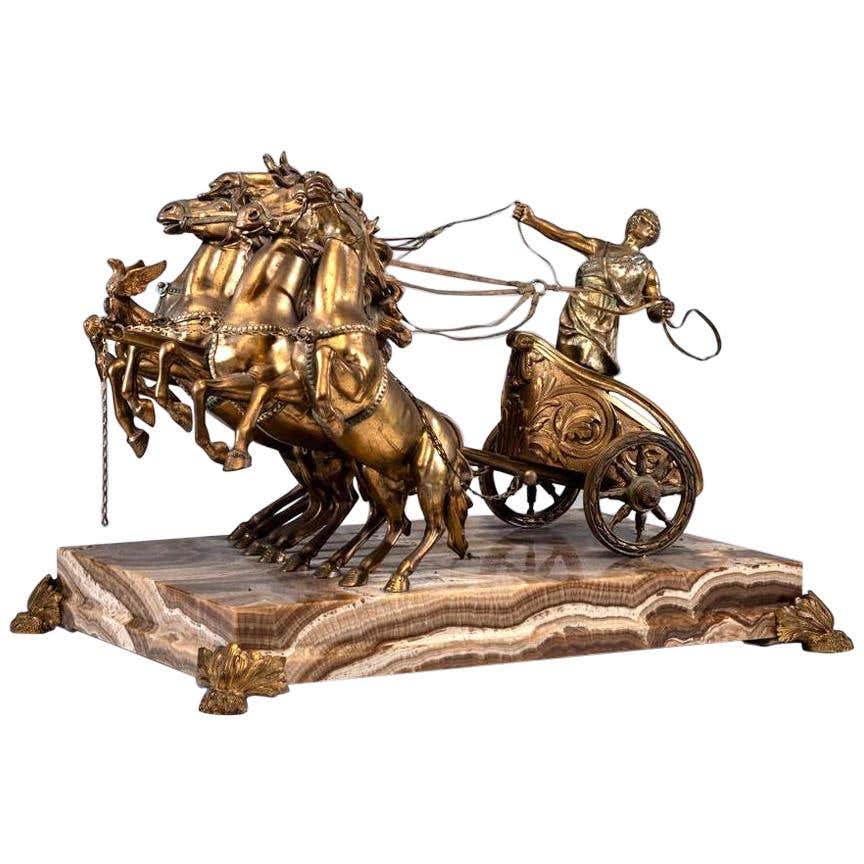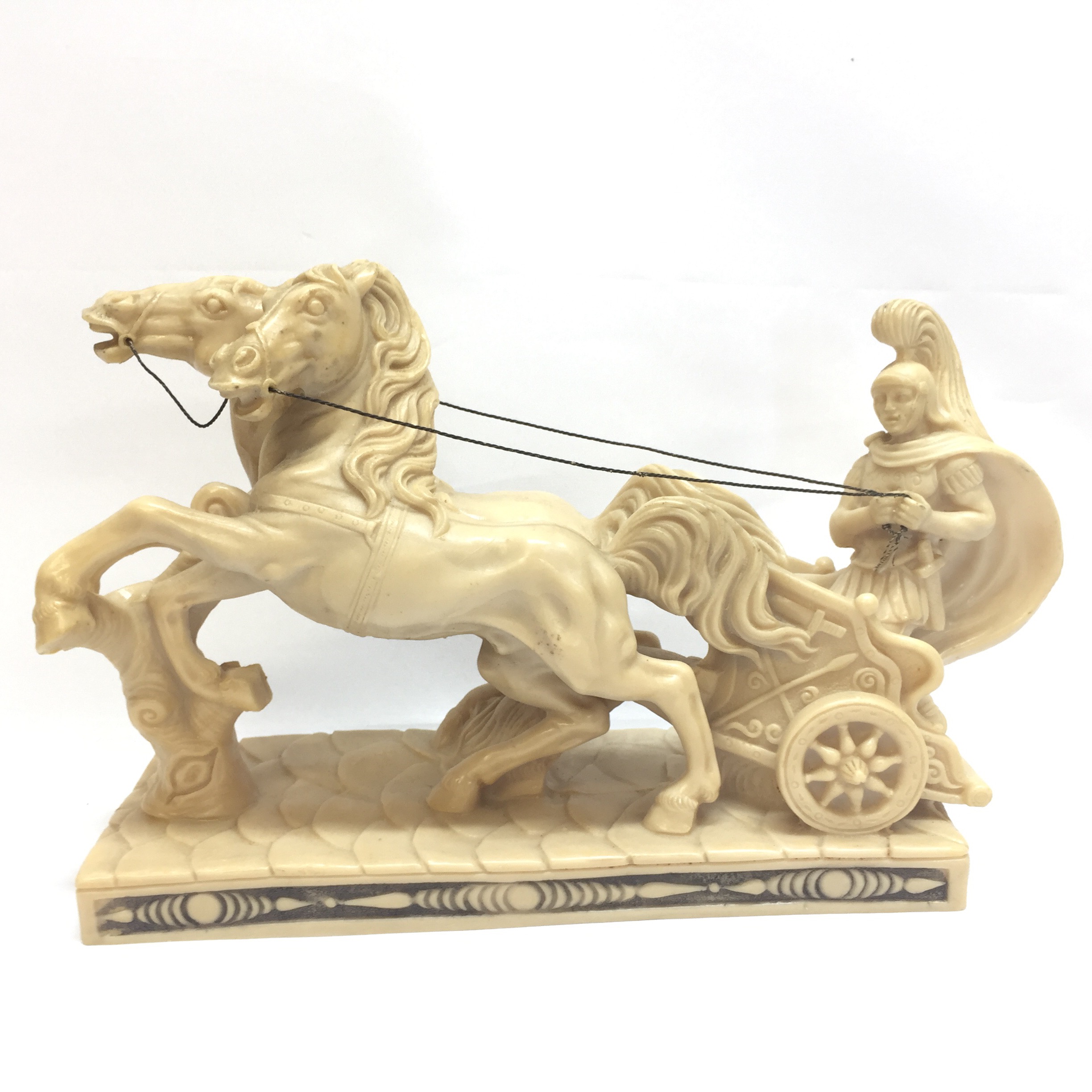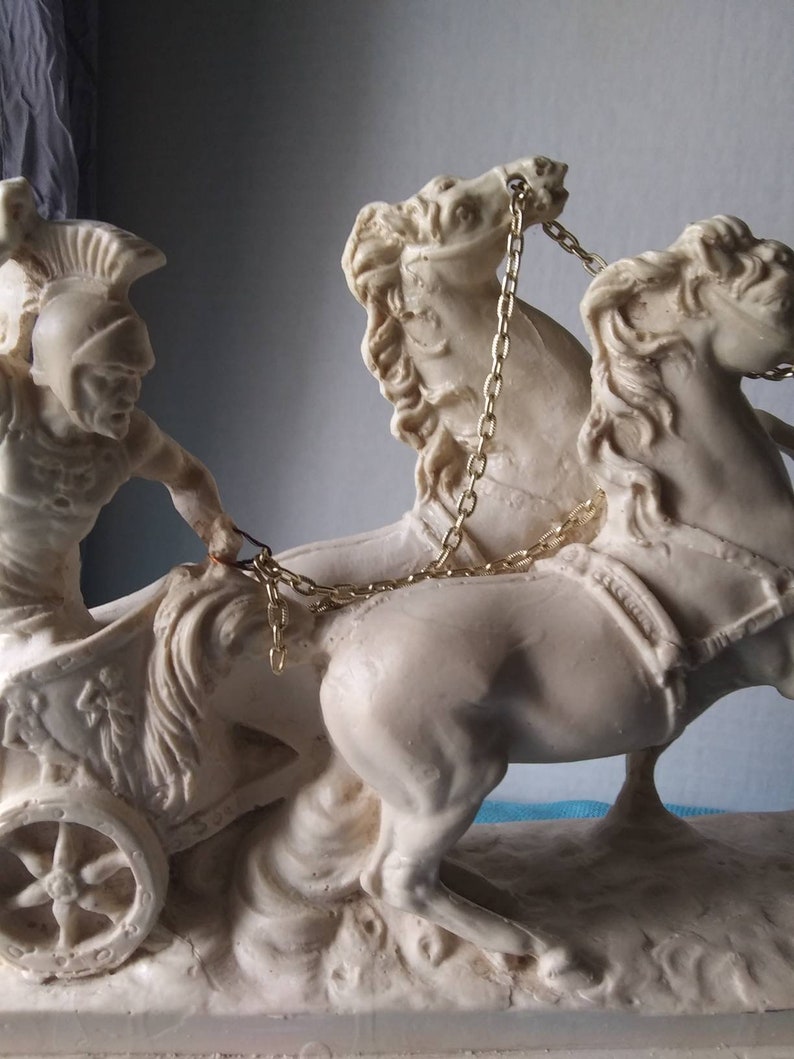
Brass Roman Chariot & Steeds Sculpture Chairish
Bronze chariot inlaid with ivory. In 1902, a landowner working on his property accidentally discovered a subterranean built tomb covered by a tumulus (mound). His investigations revealed the remains of a parade chariot as well as bronze, ceramic, and iron utensils together with other grave goods. Following the discovery, the finds passed.

Roman Chariot Sculpture Getty Museum Store
Bell 2004 S. W. Bell, Images of Chariot Racing in the Funerary Sculpture of the Roman Empire: Typology, Chronology and Context, Unpublished Ph.D. dissertation (Diss. University of Edinburgh 2004).

19th C. French Bronze And Marble Roman Charioteer Sculpture For Sale at 1stdibs
This Roman Chariot sculpture is cast of oxolyte - a material comprised of the powdered marble residue of the quarry industry bonded with resin. Hand-finished by expert Tuscan artisans in a family-owned factory operating for over 40 years. A shiny alabaster finish with a marble base. - Imported from Italy. - Dimensions: 8.5 W x 6 H x 2.75 D inches.

Bronze Roman Chariot Sculpture on Onyx Base at 1stDibs
Art of a Roman chariot. Chariot racing was one of the most popular sports in Roman history. It was a sport that lots of Romans had fans and cheered like modern sports in today's world. According to PBS, it was held at "The Circus Maximus" which could hold 200000 people. It was said that there was a sculpture called "spina" to show the fans how.

Vintage Santini Roman Chariot Sculpture Milton Wares
Roman sculpture did, however, begin to search for new avenues of artistic expression, moving away from their Etruscan and Greek roots, and, by the mid-1st century CE, Roman artists were seeking to capture and create optical effects of light and shade for greater realism. By later antiquity, there was even a move towards impressionism using tricks of light and abstract forms.

Roman Chariot Sculpture Roman Charioteer Vintage Santini Etsy
Please list any fees and grants from, employment by, consultancy for, shared ownership in or any close relationship with, at any time over the preceding 36 months, any organisation whose interests may be affected by the publication of the response.

Roman Chariot Sculpture Roman Charioteer Vintage Santini Etsy
Roman sculpture. Allegorical scene from the Augustan Ara Pacis, 13 BCE, a highpoint of the state Greco-Roman style. The study of Roman sculpture is complicated by its relation to Greek sculpture. Many examples of even the most famous Greek sculptures, such as the Apollo Belvedere and Barberini Faun, are known only from Roman Imperial or.

Bronze Sculpture "The Roman Charioteer" by Arthur Strasser (Austrian, 18541927) in 2022
Chariot. A vase showing a warrior riding a chariot pulled by a horse, from southeastern Iran, c. 2000-1800 BCE. Reconstructed Roman chariot drawn by horses. Approximate historical map of the spread of the spoke-wheeled chariot, 2000-500 BCE. A chariot is a type of cart driven by a charioteer, usually using horses [note 1] to provide rapid.

Vintage Santini Roman Chariot Sculpture Milton Wares
The Roman chariot wheel built upon knowledge gained by earlier wheelwrights in Europe and elsewhere to create multi-spoked, relatively simple and economical wooden wheels with or without iron tires. To understand the design, construction and physical characteristics of a chariot it is necessary to consider two classes of structural elements:

Signed Roman chariot rider & horse sculpture
Quadriga. Horses of Saint Mark in Venice. A quadriga is a car or chariot drawn by four horses abreast and favoured for chariot racing in Classical Antiquity and the Roman Empire. The word derives from the Latin quadrigae, a contraction of quadriiugae, from quadri-: four, and iugum: yoke. In Latin the word quadrigae is almost always used in the.

Roman Chariot Sculpture, STUHome, AAWU72011A4
Introduction. Ancient Roman sculpture, unlike the more international Greek sculpture, is not noted for its beauty or decorative qualities. This is because Roman art was not made to be beautiful, it was made to impress. It was designed to awe and impress other nations with its gravitas and sense of power. Portrait busts showed serious-looking.

Commanding Charioteer This ancient Roman charioteer commands his horses as he enters the arena
Boadicea and Her Daughters is a bronze sculptural group in London representing Boudica, queen of the Celtic Iceni tribe, who led an uprising in Roman Britain.It is located to the north side of the western end of Westminster Bridge, near Portcullis House and Westminster Pier, facing Big Ben and the Palace of Westminster across the road. It is considered the magnum opus of its sculptor, the.

Pin on
The appliqué depicts a charioteer in his quadriga, holding the victor's crown and palm branch. In Rome chariot racing was organized into teams, each identified by a color—red, white, blue, or green.. The Museum's collection of Greek and Roman art comprises more than 30,000 works ranging in date from the Neolithic period to the time of.

Roman Charioteer Statue Sculpture Free Shipping Etsy
Roman Art (500 BCE - 500 CE): Architecture, Colosseum: Relief Sculpture, Trajan's Column: Painting, Fayum Mummy Portraits.. this was the main Roman chariot racing venue in Rome, Italy. Measuring roughly 2,000 feet in length (610 metres) and 400 feet in width (120 metres), it was rebuilt in the age of Julius Caesar to seat an estimated.

Vintage Roman Soldier & Chariot Horses Sculpture Chairish
A life-size bronze statue of a man named Aule Metele, commonly known as The Orator, dates back to the early 1st century B.C.E., and alludes to the origins of the Roman Empire. The Orator raises his arm to a crowd; although he is Etruscan, he wears an outfit typical of a Roman magistrate: a short toga and boots.

Roman Chariot Statue Sculpture Bronze Figurine.epsteam
The Charioteer of Delphi, Delphi Museum Charioteer of Delphi, head. The Charioteer of Delphi, also known as Heniokhos (Greek: Ἡνίοχος, the rein-holder), is a statue surviving from Ancient Greece, and an example of ancient bronze sculpture.The life-size (1.8m) statue of a chariot driver was found in 1896 at the Sanctuary of Apollo in Delphi. It is now in the Delphi Archaeological Museum.